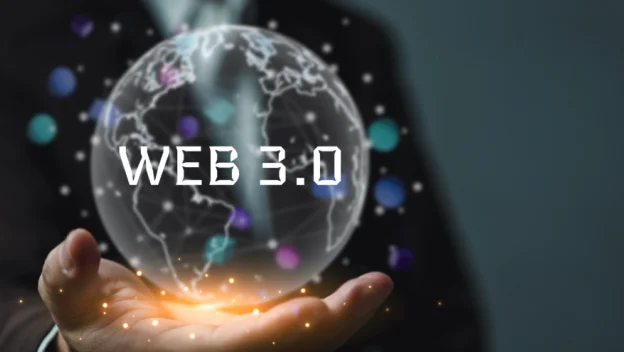Innovations Web 3.0 Brings to Business Models
Discover the definition, key features, cloud infrastructure implications, data ownership, and the impact of Web 3.0 on blockchain-driven business models—all centered around decentralization.
Discover the definition, key features, cloud infrastructure implications, data ownership, and the impact of Web 3.0 on blockchain-driven business models—all centered around decentralization.

Known for its decentralized architecture, Web 3.0 can be described as the result of a process that began with the emergence of Bitcoin in the early 2000s. Following the Web 2.0 era—where individuals could generate and share content or create blogs—this new phase prompts the question, What is Web 3.0? You'll find detailed answers throughout this article.
As briefly mentioned above, Web 3.0 builds upon Web 2.0 but also distinctly diverges from it. In short, the Web 3.0 Semantic Web represents the next evolutionary stage of the internet—decentralized and user-centric. This new-generation internet architecture is specifically designed to return data ownership to individuals. With blockchain technology at its core, Web 3.0 enables users not just to generate data, but to gain full control of it as well. Thus, at the heart of Web 3.0 lies a model where data is processed and shared independent of centralized authorities. For example, while most of today’s data is stored on centralized servers owned by tech giants like Facebook or Google, in Web 3.0, data is distributed across a blockchain network and secured—offering users significant advantages in both security and privacy.
On the topic of data storage, you may also be interested in our article, Which Cloud Solution Is Best for Businesses? Public, Private, or Hybrid Cloud.
Beyond individual users, Web 3.0 technologies also introduce game-changing innovations for the business world. For instance, companies can use smart contracts to build more transparent and trustworthy business models. Additionally, AI- and machine learning–powered algorithms help interpret online data, enhancing user experiences. As a result, businesses across various industries are looking to leverage this transformative technology.

Below is a list of the most widely used Web 3.0 tools.
Because decentralization is its foundational principle, Web 3.0 has the potential to revolutionize how businesses operate when combined with cloud infrastructure. While traditional cloud models operate through centralized data centers, Web 3.0’s decentralized cloud technologies ensure that data is processed more securely, swiftly, and accessibly. This, in turn, allows businesses to reduce operational costs and improve data security—making the model especially valuable. Additionally, with decentralized storage systems, businesses can significantly minimize data loss risks while building sustainable and reliable operational infrastructures.
Another major innovation Web 3.0 brings to cloud infrastructure is the integration of smart contracts and blockchain technology. These capabilities introduce transparency and automation into business models, reducing fraud risk and minimizing manual processes. For example, in supply chain management, blockchain-based systems can enhance traceability and build greater trust among partners. These innovations are already reshaping business models across finance, e-commerce, healthcare, and logistics—making processes far more efficient.

All of this suggests that Web 3.0 is setting a new standard for security and transparency in cloud services. Web 3.0 technologies are fundamentally changing the traditional approach to cloud infrastructure. How? By encrypting and distributing data across a decentralized blockchain network. This not only ensures higher resistance against cyberattacks, but also enables real-time transparency of all transactions and data flows—an invaluable trust builder between businesses and users.
Among the many advantages of Web 3.0 is the ability of smart contracts to ensure automation and accuracy in cloud services. For instance, whether a service provider meets its obligations can be automatically tracked on the blockchain. Moreover, decentralized storage solutions like IPFS not only reduce the risk of data loss but also prevent manipulation by any central authority. As you might expect, such capabilities are transformative—particularly in sectors like healthcare, finance, and law where sensitive data is critical.
While Web 3.0 is often associated with blockchain and smart contracts, it also includes compatible cloud storage services and providers such as Filecoin or IPFS. Below are some of the most common Web 3.0 examples.
Compared to systems governed by central authorities, decentralized models offer users far greater transparency regarding data ownership. For example, users can track who accessed their data, when, and for what purpose—all through blockchain visibility. These systems also safeguard data from unauthorized access. Moreover, managing sensitive information such as medical records, financial details, or corporate data through decentralized structures helps both businesses and individuals operate more securely in the digital age. In essence, this new paradigm is reshaping cloud services in areas like digital identity verification, data sharing, and sensitive data management—highlighting the business value Web 3.0 brings.
If you're looking to harness the benefits of cloud infrastructure and want to explore tailored, finance-ready managed services, reach out to us. With its comprehensive portfolio, GlassHouse Cloud Services ensures seamless transitions across all your processes.
You may also want to read our article on What Is Digital Transformation?
Complete the form to get in touch with us! Let's build the infrastructure of success for your IT operations together.